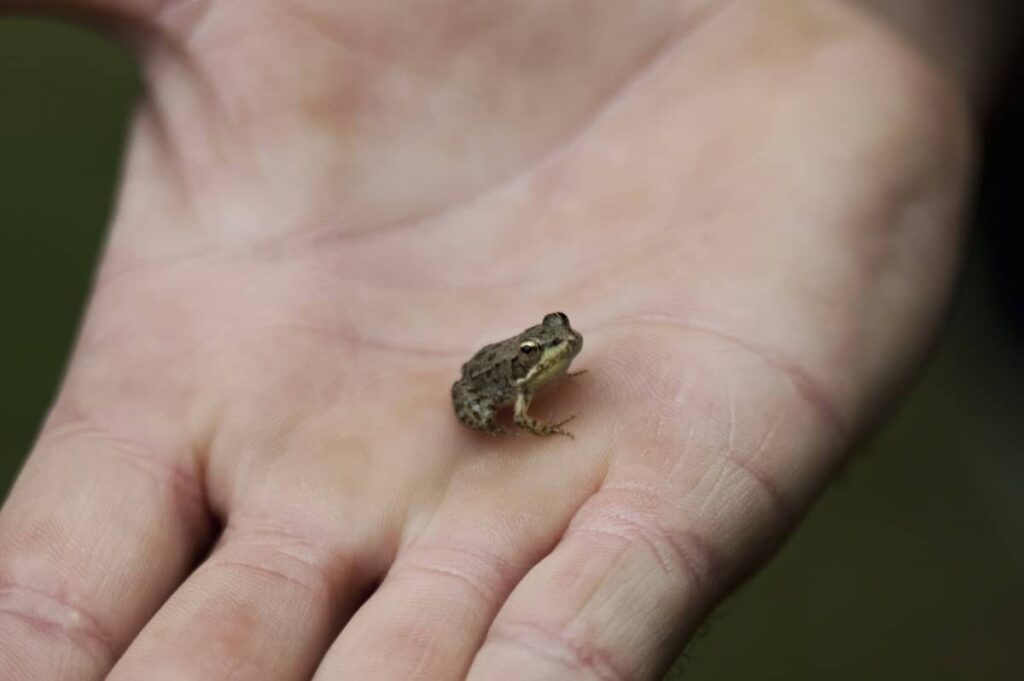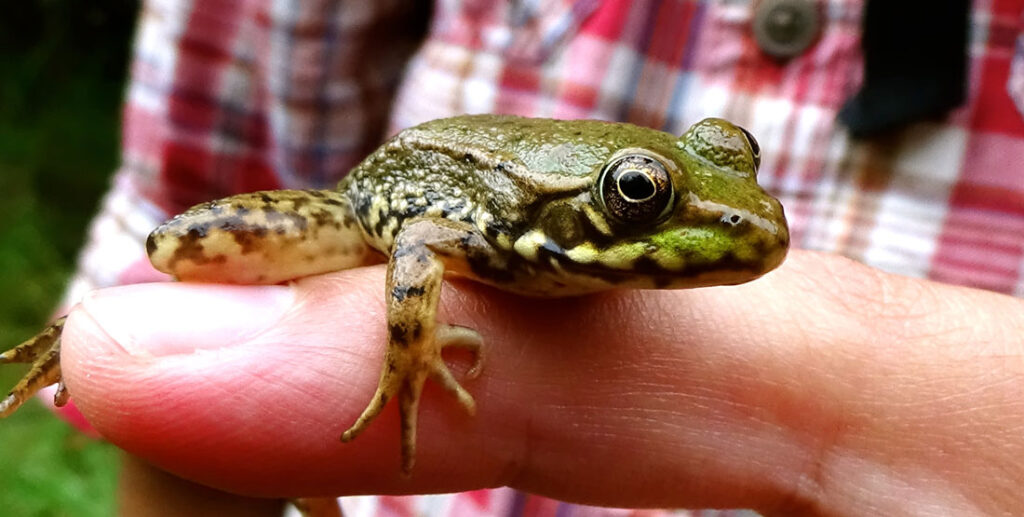If you find a frog in your house and need to catch it, there are a few simple steps you can take.
- First, remain calm and avoid startling the frog.
- Next, gather any necessary supplies, such as gloves and a container with a lid.
- Approach the frog carefully, making sure to block its escape routes.
- Use gentle and slow movements to capture the frog, being mindful of its delicate nature.
- Once caught, carefully place the frog in the container and release it back into its natural habitat outdoors.
- Wash your hands after handling the frog to maintain hygiene.
How to Catch A Frog in Your House?

Finding a frog in your house can be an unexpected and unsettling experience. Not only can they cause disturbances and create a mess, but it is also important to remove frogs from your house for various reasons.
Firstly, frogs can carry bacteria and parasites that pose health risks to humans and pets. Additionally, their croaking can disrupt sleep and daily activities.
Furthermore, keeping frogs out of your home helps maintain a clean and hygienic living environment.
However, here are the effective techniques to catch frogs and safely release them back into their natural habitats.
Preparation
A. Gathering the necessary supplies
Before attempting to catch a frog in your house, prepare the following supplies:
- A small container like a cup or a box with a lid,
- A piece of stiff cardboard or paper,
- And gloves if you prefer not to handle the frog directly.
B. Creating a safe catching environment
Ensure the room is well-lit to have a clear view of the frog’s movements. Remove any obstacles that could hinder your efforts or provide hiding spots for the frog.
C. Ensuring the safety of both yourself and the frog
Wear gloves if you have them to protect your hands from any potential contaminants on the frog’s skin. This also prevents skin oils and chemicals from harming the frog.
Techniques for Catching a Frog
A. The “hands-on” approach
Proper hand positioning: Gently approach the frog, keeping your hands low and your palms open. This minimizes the frog’s stress and reduces the risk of it jumping away.
Maintaining a calm demeanor: Approach the frog slowly and calmly. Sudden movements or loud noises can frighten it and make catching it more challenging.
Capturing the frog securely: Once your hands are close enough, quickly but gently cup the frog in your hands, taking care not to squeeze it too tightly. Hold it firmly but not aggressively.
B. Utilizing a humane catch-and-release method
When it comes to capturing and relocating a frog using a humane catch-and-release method, several steps are involved, from constructing a homemade trap to luring the frog and ultimately relocating it to its natural habitat.
Here’s a detailed guide based on utilizing the human catch-and-release method for catching the frog.
1. Constructing a Homemade Trap:
Materials: To build a homemade trap, gather a few simple materials: a small container (like a plastic food container with a lid), a piece of string or dental floss, and a stick or twig.
Prepare the Container: Cut a small hole near the top of the container’s lid, just big enough for the string to pass through. Make sure the lid is securely attached to the container.
String and Stick: Thread one end of the string through the hole in the lid, leaving the other end hanging outside the container. Attach the stick to this end of the string, positioning it to allow you to pull the stick to close the lid.
Bait the Trap: Place a small amount of bait inside the container. Frogs are attracted to insects like crickets, flies, or mealworms, so use one of these as bait.
2. Luring the Frog into the Trap:
Choose the Right Location: Place the homemade Trap in an area where you’ve seen the frog or where you suspect it might hide. Frogs are often near water sources or in damp, shady spots.
Wait Patiently: Be patient as you wait for the frog to investigate the bait. Frogs are curious creatures and will often approach potential food sources.
Using a Light Source: If it’s nighttime, you can gently shine a flashlight near the Trap to attract insects, which may entice the frog to come closer.
Act Calmly: When the frog enters the Trap to reach the bait, act calmly and avoid sudden movements to prevent scaring it away.
3. Relocating the Frog to Its Natural Habitat:
Capture the Frog: Once the frog is inside the Trap, gently pull the string attached to the stick to close the lid. Make sure not to harm the frog in the process.
Handling the Frog: Carefully lift the Trap and the captured frog, ensuring you don’t shake or jostle it too much.
Release It: Take the frog to an appropriate release location. This should be near a water source or a suitable natural habitat for frogs. Ensure it’s far enough from your home to discourage its return.
Open the Trap: Slowly and gently open the Trap to allow the frog to hop out and into its new environment. Give it time to adjust before leaving the area.
Troubleshooting Common Challenges

When dealing with frogs in your house, various challenges may arise, including the elusiveness of the frog, the need to avoid harm or injury, and preventing future frog invasions. Here’s how to address these challenges:
A. Dealing with a Particularly Elusive Frog
Catching an elusive frog can be tricky, as they are agile and can hide in tight spots. Here’s how to handle this challenge:
Observation and Patience: Start by carefully observing the frog’s behavior. Take note of its movements and hiding spots. Exercise patience and avoid sudden movements that might scare it away.
Appropriate Equipment: Use a container or net that suits the frog’s size and agility. Smaller, more maneuverable tools are often more effective.
Create a Barrier: Gently guide the frog towards a corner or open space using objects like books or cardboard. By limiting its escape routes, you increase your chances of capturing it.
Team Effort: Enlist the help of someone else, if possible. Having someone to help can make it easier to corner and catch the frog.
Light Attraction: Frogs are drawn to light sources. Turn off most lights in a room with multiple exits, leaving one on near an open container or net. The frog may hop toward the light source, making capture more manageable.
Minimize Disturbances: Make slow, deliberate movements. Sudden actions can startle the frog, causing it to hide deeper or become more evasive.
B. Avoiding Potential Harm or Injury
Ensuring safety for both you and the frog is paramount when catching it. Here’s how to avoid potential harm or injury:
Use Gloves: Always wear gloves when handling frogs. Some species secrete toxins or have sensitive skin that can be harmful. Gloves protect your hands and minimize stress on the frog.
Gentle Handling: Handle the frog as gently as possible. Frogs have delicate skin and bones, so avoid squeezing or holding them too tightly.
Choose Soft Containers: When using a container to capture the frog, select one with smooth edges to prevent injury. Avoid containers with sharp or rough edges.
No Harmful Chemicals: Refrain from using chemicals or substances like insecticides to capture frogs, as these can be harmful to both you and the frog.
Environmental Awareness: Be mindful of your surroundings while trying to catch the frog. Prevent accidents by avoiding tripping or bumping into objects. Ensure a clear path for safe movement.
Prompt Release: Once caught, release the frog outdoors promptly, far from potential dangers inside your home.
Consult Experts: If you’re uncertain about the frog’s species or handling requirements, consult local wildlife authorities or herpetologists for guidance.
C. Preventing Future Frog Invasions
To keep frogs out of your house in the future, consider these preventive measures:
Seal Entry Points: Check your home for gaps and seal them to keep frogs out.
Close Doors and Windows: Ensure doors and windows are properly closed, especially when frogs are more active in the evenings.
Install Screens: Use window and door screens without tears or holes to keep frogs from hopping in.
Outdoor Lighting: Use outdoor lighting sparingly since bright lights can attract insects, which can, in turn, attract frogs.
Landscaping: Remove standing water sources near your home, such as puddles or containers. Frogs are attracted to moisture.
By following these guidelines, you can troubleshoot common challenges when dealing with frogs in your house while also taking steps to prevent future invasions and ensure your and the frogs
FAQs
1. Why is there a frog in my house?
Frogs can enter homes seeking shelter or food. They’re attracted to insects and cool, damp areas.
2. Is it safe to catch a frog by hand?
Yes, it’s usually safe to catch a frog by hand but wash your hands afterward to avoid any potential contamination.
3. What should I do if I find a frog indoors?
Use a container or cup to trap the frog gently, then release it outside, away from your home.
4. Can I use chemicals to catch a frog?
Using chemicals to catch frogs is not recommended, as it can harm them and the environment.
5. How can I prevent frogs from entering my house?
Seal cracks and gaps in the doors and windows of your house, and turn off outdoor lights at night to avoid attracting insects.
6. Are frogs dangerous to have in the house?
No, Frogs aren’t dangerous to have in the house, but they can carry diseases, so it’s best to handle them with care.
7. What should I feed a frog I’ve caught indoors?
If you catch a frog, it’s best to release it outdoors, where it can find its natural food.
8. How can I make my home less frog-friendly?
Reduce moisture indoors, fix leaks, and ensure good ventilation to make your home less attractive to frogs.
9. Can frogs damage my home?
No, Frogs typically don’t cause structural damage to homes, but their presence may be a sign of other issues like leaks.
10. Is it illegal to catch frogs in my house?
In most cases, it’s not illegal to catch frogs inside your own home but check local regulations to be sure.
Conclusion
Catching a frog in your house can be a challenging but rewarding experience.
By following our guidelines here, you can remove the frog from your home and feel accomplished.
Embrace the unexpected visits from nature and use this opportunity to appreciate the wonders it brings.
Celebrate your success in achieving a frog-free living environment and embrace the beauty of unexpected encounters with nature.
